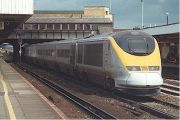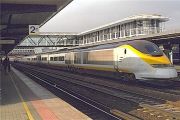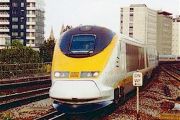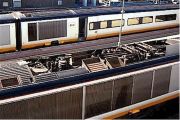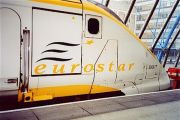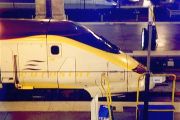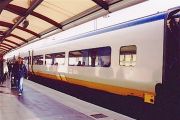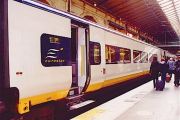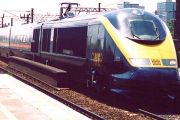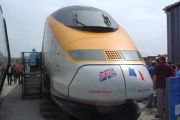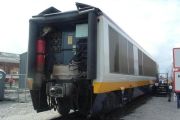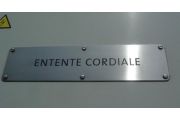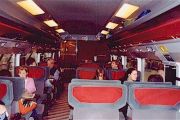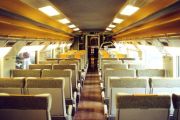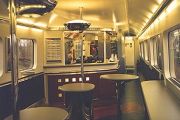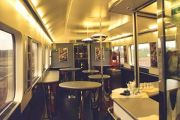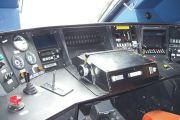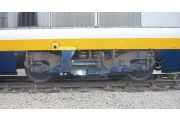Please be aware of our copyright notice. If you have a good reaon for using a photo from this site ask permission from first - it is frequently given.
Trans Manche Super Trains (TSMTs) - class 373
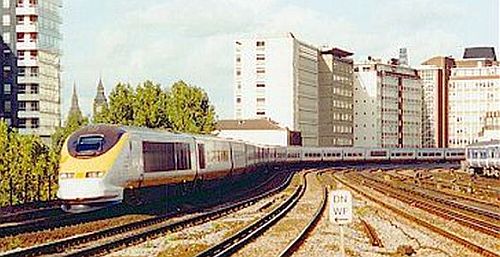
photograph by Colin Duff
|
| In the run up to the opening of the Channel Tunnel
contracts were placed in December 1989 for the construction of thirty one TMST
(Trans Manche Super Train) units. GEC-Alsthom was the main contractor using a
number of sub contractors in Belgium, Britain and France, in particular Brush
of Britain supplying the traction motors and de Dietrich of France building the
body shells of the trailer cars. The power cars were built at the GEC-Alsthom
works at Belfort in France and a large part of the final construction was
carried out at the former Metro Cammel plant (GEC-Alsthom having acquired the
company) at Washford Heath.
TMST units are technically complex having to accommodate three different operating voltages and pickups (750v DC third rail UK, 25kV AC overhead Channel Tunnel and France, 3kV DC overhead Belgium), three different 25kV catenary heights (Eurotunnel - high for the Shuttle, French LGV - fixed at 5.1m, and variable height on normal French lines), three different methods of railway operation, and three different platform heights (France 550mm above track height, Belgium 760mm and Britain 36 inches). Changes between voltage and pickup are designed to be done on the move. Each driving power car has two pantographs - one for 25kV AC and one for 3kV DC - and both bogies have retractable pickup shoes for use on 750v DC lines. Different platform heights are dealt with by retractable steps for use when in Belgium and France. All cars are of steel construction - the long nose of the 22.15 m long driving power cars being of glass reinforced plastic with a steel safety cage. The trailer cars, which are 18.70 m long, except for the MS and TBF which are 21.85 m long, are built to a monocoque (no separate chassis) design and adjacent non powered cars are articulated about a shared bogie. The overall unit is built to less than the Continental UIC loading gauge to be able to run in Britain without requiring major building work to widen lines and raise overhead structures In service twenty car formations are run of two mirrored ten car units consisting of DM, MS, 4TS, RB, 2TF and TBF. Each running formation has 12 asynchronous traction motors, 8 axles on the power cars and 4 axles on the outer bogies of the leading coaches. Power output from a TMST is not the same on all voltages - the maximum power of 16,408hp (the power/weight ratio is 50% less than for a TGV Nord set) is only available when operating at 25kV. The maximum power when operating on 750v DC is roughly 28% of that total. The units have two types of braking. Non powered wheels have disc brakes. Powered wheels have pneumatically operated brake shoes for use under 25mph or in an emergency. At higher speeds the powered wheels use rheostatic braking. At the maximum speed of 186 mph (never reached in the UK!) the train can stop in 2.2 miles. The thirty one units were divided between the partners in the Eurostar service consortium, the SNCF owning sixteen, BR EPS (European Passenger Services) eleven and SNCB four. The first test run of the PS (pre-series) 1 unit - consisting of power car 3001 and 3002 plus seven trailer cars - was on 28th January 1993 from Strasburg Ville. A run at 100mph was recorded the next day. On 20 June 1993 the first TMST ran through the Channel Tunnel. The Channel Tunnel was opened by the H.M. The Queen and President Mitterrand on 6th May 1994. The first London to Paris staff familiarisation purposes ran on 2th June 1994 and the services between London and Paris or Brussels - marketed as Eurostar - began on 14th November 1994. Today the British partner in the Eurostar consortium is London and Continental Railways, which is jointly owned by British Airways and National Express. In the autumn of 1999 four French owned sets, 3203/4 and 3227/8, were withdrawn from the Eurostar pool by SNCF to work internal services between Paris and Lille. Subsequently 3225/6 has also been withdrawn from the Eurostar pool. These units wear a livery of grey with silver ends and display a TGV emblem. Mention should be made of the eight regional Eurostar sets ordered at the same time by BR for use on planned international services originating and terminating beyond London. Sixteen car services were intended to be formed of pairs of eight car units made up DM, MS, 3TS, RB, TF and TBF, however the services are not thought to be viable and for most of the time the expensive stock has remained in store. From 28th May 2000 two pairs of this stock (usually 3301-4) were hired to GNER to provide additional capacity on their "White Rose" service between Kings Cross and York. Subsequently this UK domestic TMST operation was moved to the Kings Cross to Leeds route and a third unit pair was hired. Currently 3301/2/4/4/5/6 carry GNER livery for this purpose although other regional sets are substituted when these are required for maintenance. |
|
This page was last updated 26 July 2004
